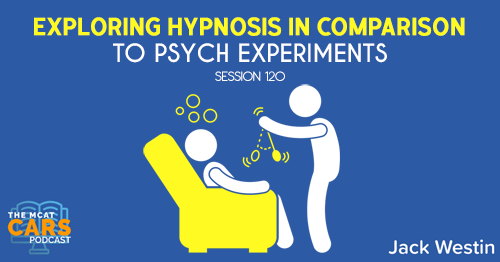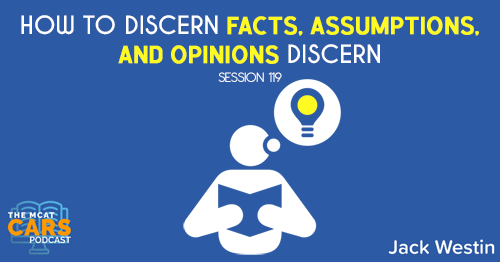Apple Podcasts | Google Podcasts

Session 36
Gotham, the font, is found everywhere from Netflix to Spotify to Twitter. The design of Gotham makes it easy to read, but can you find the reason Gotham is everywhere?
As always, we’re joined by Jack Westin, the leader in MCAT CARS prep course. If you haven’t yet, go check out JackWestin.com. Sign up for their daily CARS passages sent right into your email inbox.
Link to article:
https://theoutline.com/post/7356/gotham-font-is-everywhere?zd=1&zi=uxcooekv
When I close my eyes and think of a word, I picture that word in Gotham. I am cursed with the compulsive need to identify every typeface I come across, but even if you do not suffer this particular affliction — if your relationship to typography resembles your relationship to air, a constant interaction so seamless you hardly think about it unless something goes seriously awry — you know this font. If you’ve been online, seen a billboard, gone to a movie theater, or walked down the street with your eyes open, you’ve seen Gotham.
Gotham is a typeface first designed in 2000 for GQ and released for public use in 2002. An abbreviated list of where it has appeared includes: Coke bottles; Twitter; Spotify; Netflix; Saks; New York University; The Tribeca Film Festival; TV shows including CONAN and Saturday Night Live; movies including Inception, Moneyball, The Lovely Bones, and Moonlight. If the advertisements in the train stations and bus stops in your city don’t use Gotham, they probably use a Gotham look-alike.
Gotham is everywhere, as the name of one of the Tumblr accounts dedicated to tracking its prevalence suggests, but how did it become so ubiquitous? How does a typeface take over so thoroughly in such a short period of time — and what do advertisers across every industry like so much about it?
The simplest answers are the technical ones. Gotham is a geometric sans serif — sans serif meaning it lacks the little feet in the corners of letters you’d see in a typeface like Times New Roman, and geometric alluding to the influence of basic shapes in its design. It has a high x-height, meaning that lowercase letters like x and e are comparably large, and its different weights — bold, thin, medium, et cetera — are very distinct from one another. All of this is to say that Gotham can be easily read from a distance on a billboard or sign, making it a natural choice for print advertising.
In fact, Gotham finds its typographic roots in much of the 20th-century architectural signage commonly found in New York City. Oddly enough, the geometric signage on the front door of the Port Authority — not a place many people associate with hipness — served as an inspiration for Gotham’s creator, type-industry titan Tobias Frere-Jones.
[02:03] Dealing with Challenging, Boring Topics
Reading boring stuff on a consistent basis is helpful. Jack Westin offers daily passages you can practice with so you can get used to reading boring stuff. Whatever topic is challenging for you, then read more of those on a consistent basis. This way, your brain can be accustomed to those kinds of ideas, theories, or topics. Then you’re less likely to zone out or just stop reading completely.
[03:42] Paragraph 1, Sentence 1
When I close my eyes and think of a word, I picture that word in Gotham.
Jack says:
The first thing we picture out here is Batman and Gotham City. But maybe this is a different Gotham for the author. So we don’t know until we keep reading.
[04:10 Paragraph 1, Sentence 2
I am cursed with the compulsive need to identify every typeface I come across, but even if you do not suffer this particular affliction — if your relationship to typography resembles your relationship to air, a constant interaction so seamless you hardly think about it unless something goes seriously awry — you know this font.
Jack says:
So the author is referring to Gotham, the font – not the city.
[04:58] Paragraph 1, Sentence 3
If you’ve been online, seen a billboard, gone to a movie theater, or walked down the street with your eyes open, you’ve seen Gotham.
Jack says:
The author is saying that Gotham is a comon font as you can see it everywhere.
[05:22] Paragraph 2, Sentence 1
Gotham is a typeface first designed in 2000 for GQ and released for public use in 2002.
Jack says:
GQ is a magazine and they say about the font being released and introduced. People actually create fonts and they’re being paid for it.
[06:22] Paragraph 2, Sentence 2
An abbreviated list of where it has appeared includes: Coke bottles; Twitter; Spotify; Netflix; Saks; New York University; The Tribeca Film Festival; TV shows including CONAN and Saturday Night Live; movies including Inception, Moneyball, The Lovely Bones, and Moonlight.
Jack says:
The author is showing us examples of where the font appears to emphasize it’s basically everywhere.
[06:58] Paragraph 2, Sentence 3
If the advertisements in the train stations and bus stops in your city don’t use Gotham, they probably use a Gotham look-alike.
Jack says:
Even if it’s not Gotham, people are still using a font based on Gotham. (Trivia: Jack Westin’s logo is Gotham)
[07:33] Paragraph 3, Sentence 1
Gotham is everywhere, as the name of one of the Tumblr accounts dedicated to tracking its prevalence suggests, but how did it become so ubiquitous?
Jack says:
The author is now setting the question as to hwy it became so popular.
[07:50] Paragraph 3, Sentence 2
How does a typeface take over so thoroughly in such a short period of time — and what do advertisers across every industry like so much about it?
Jack says:
The author is asking why the font is so popular and why everyone is using it so much?
[08:12] Paragraph 4, Sentences 1-2
The simplest answers are the technical ones. Gotham is a geometric sans serif — sans serif meaning it lacks the little feet in the corners of letters you’d see in a typeface like Times New Roman, and geometric alluding to the influence of basic shapes in its design.
Jack says:
The first sentence of the paragraph is talking about the technical side of the font. This can get a lot of students stressed out. They know Times New Roman and they have seen these words, but not to understand them. You may want to visualize the font to the best of your ability. Paint the picture.
[09:30] Paragraph 4, Sentence 2
It has a high x-height, meaning that lowercase letters like x and e are comparably large, and its different weights — bold, thin, medium, et cetera — are very distinct from one another.
Jack says:
The author presents more technical information here.
[10:00] Paragraph 4, Sentence 3
All of this is to say that Gotham can be easily read from a distance on a billboard or sign, making it a natural choice for print advertising.
Jack says:
The author is now saying that it’s easy to read.
[10:51] Paragraph 5, Sentence 1
In fact, Gotham finds its typographic roots in much of the 20th-century architectural signage commonly found in New York City.
Jack says:
Maybe this is where the name comes from since Gotham is a fictional New York City.
[11:10] Paragraph 5, Sentence 2
Oddly enough, the geometric signage on the front door of the Port Authority — not a place many people associate with hipness — served as an inspiration for Gotham’s creator, type-industry titan Tobias Frere-Jones.
Jack says:
This is giving us a little bit of history of Gotham and who the creator is.
[11:53] The Main Idea
Gotham, the font, is used everywhere because it’s easy to read. It’s good for advertising. This is the point that the author wants you to know.
A lot of students may not understand why Gotham is everywhere because the author said it in a subtle way at the end of the paragraph. So if you get tied up to the technical stuff, you may have lost the point the author was trying to make.
The MCAT may pose a question about an advertisement that’s hard to read. Then the questions will possible based on the fact that Gotham is easy to read. So be very careful with what you’re reading and make sure you understand the points they’re trying to make.
Links:
Link to article:
https://theoutline.com/post/7356/gotham-font-is-everywhere?zd=1&zi=uxcooekv
SEARCH SITE
SEARCH SITE
LISTEN FOR FREE











